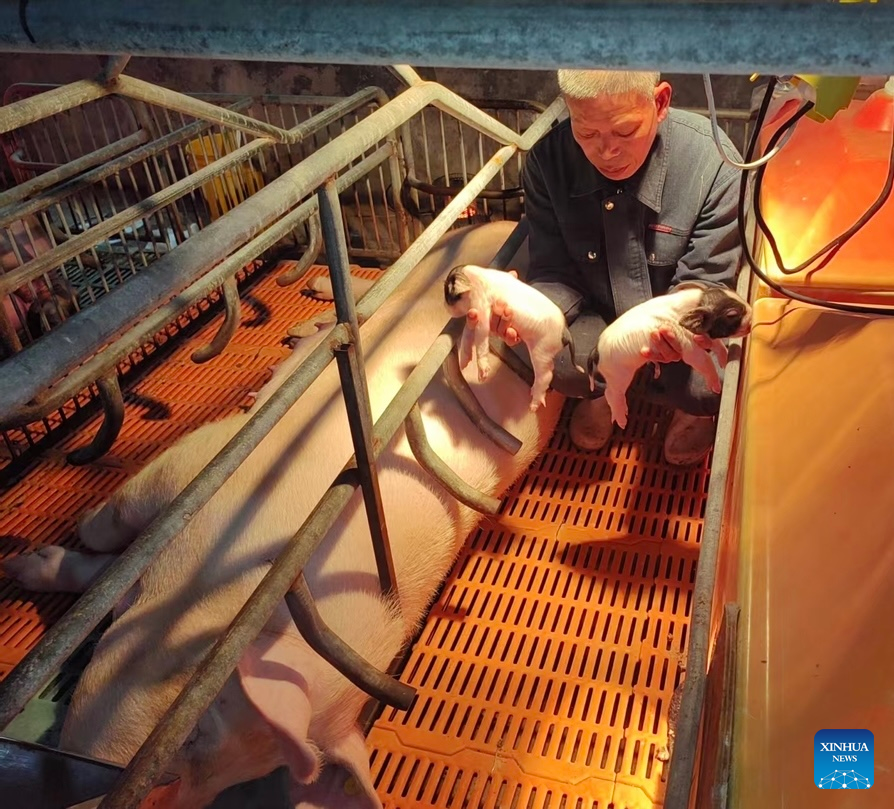
This undated photo shows two cloned Shaziling piglets, delivered via surrogate mother, in Xiangtan, central China's Hunan Province. (Xiangtan municipal livestock breeding station/Handout via Xinhua)
CHANGSHA, Feb. 5 (Xinhua) -- Two cloned piglets born in central China's Hunan province are expected to promote China's pork industry and diabetes treatment research while preserving a 4,000-year-old local breed once pushed to the brink by foreign competitors.
According to the Xiangtan municipal livestock breeding station, the cloned Shaziling piglets, delivered via surrogate mother on Jan. 24 in Xiangtan County, mark a milestone in China's decade-long push to preserve indigenous livestock breeds using biotechnology.
Once a staple in Hunan's famed hongshao rou (braised pork), Shaziling pigs, a breed native to Xiangtan, nearly vanished as industrial foreign breeds dominated Chinese farms in previous years.
It is considered a precious genetic resource and was added to China's national animal genetic resource protection list in 2006.
To protect the genetic resources of the Shaziling pig, the breeding station initiated the somatic cell cloning experiment with support from a research team led by Yin Yulong, a Chinese Academy of Engineering academician and chief researcher at the Insitute of Subtropical Agriculture under the Chinese Academy of Sciences, starting in June 2024.
Researchers utilized frozen ear tissue cells from Shaziling pigs to create fibroblast cells, leading to successful embryo construction, cultivation, and transplantation. On Jan. 24, the surrogate mother pig successfully gave birth.
Tan Hong, head of the breeding station, said that the two piglets display characteristic features of the Shaziling pig, such as a short snout, butterfly ears, and cow-like eyes. They are healthy and being cared for by skilled technicians.
Yin noted that the research achievement goes far beyond agriculture.
He emphasized the anatomical, physiological, immunological, and genomic similarities between pigs and humans. These similarities make pigs ideal models for diseases such as diabetes and cardiovascular ailments. Their similar organ size and structure enhance their prospects in xenotransplantation research.
Wu Maisheng, a researcher at the Xiangtan Municipal Bureau of Agriculture and Rural Affairs, revealed that porcine-human xenotransplantation studies conducted in Hunan since 2005 have found that the Shaziling pig possesses the highest biosafety and is the best donor for such transplants. The success rate for using Shaziling pig islet cells in diabetes treatment reached 95.45 percent.
Wu said the birth of the cloned Shaziling pig facilitates long-term preservation and live recovery of genetic resources, providing a valuable experimental model for innovative conservation methods for high-quality local pig breeds.
Future research will focus on the cloned pigs' adaptability to environmental conditions, growth, and reproductive performance, as well as in-depth studies of the progeny's weight gain, meat quality, and genetic traits.
Yin also said that the Shaziling pig presents extensive application prospects as a food source, disease model, and donor for xenotransplantation. It is increasingly significant in modern agriculture, medical research, and clinical treatments.
The research team aims to utilize cloning technology to replicate superior Shaziling pigs with high feed conversion rates, meat yield and quality. ■



